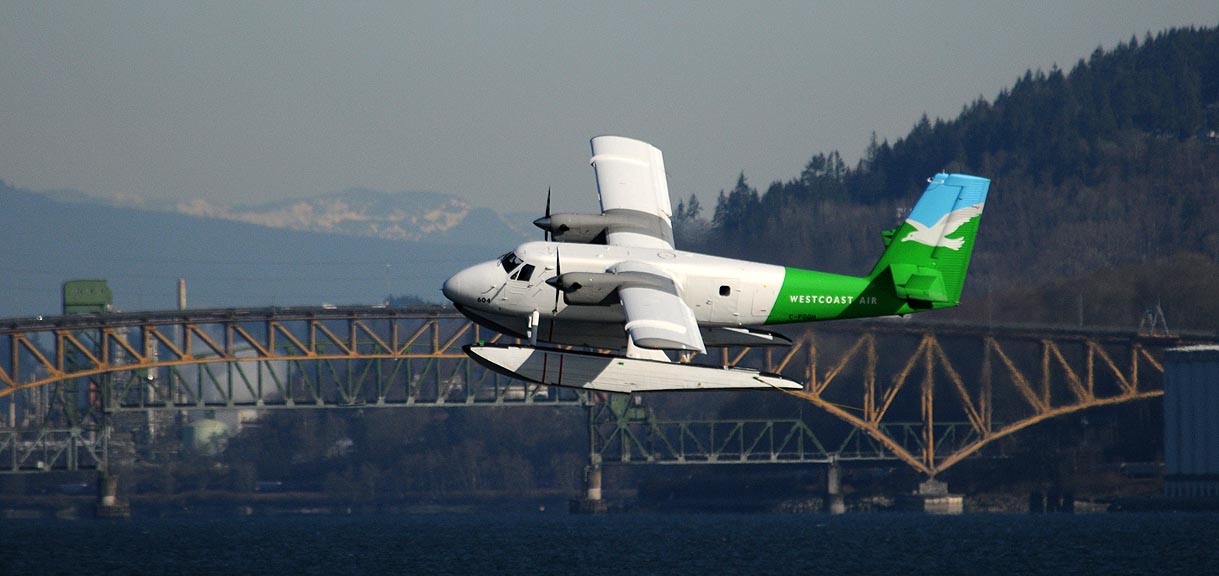
News
Vancouver harbour – aviation then and now
Dec. 2, 2011 - Tony Bennett sang of San Francisco and the “little cable cars climbing half-way to the stars,” but there’s no tune (yet) to the floatplanes and helicopters that rise from Vancouver harbour with the snowcapped mountains as their backdrop.
December 2, 2011 By Paul Dixon
Dec. 2, 2011 – Tony Bennett sang of San Francisco and the “little cable
cars climbing half-way to the stars,” but there’s no tune (yet) to the
floatplanes and helicopters that rise from Vancouver harbour with the
snowcapped mountains as their backdrop.
The same year the City of Vancouver designated a field on Lulu Island as its airport, William Boeing bought a shipyard on the downtown waterfront, where the Westin Bayshore stands today, though photos exist of Mr. Boeing at the controls of a seaplane in Vancouver harbour in 1914. Starting with four Model 204 (B-1E) four-seat flying boats, the Boeing continued building seaplanes and flying boats for almost 20 years, before selling the property to BC Packers at the end of the Second World War.

|
|
| Westcoast Air Twin Otter taking off from Vancouver harbour (CXH). 2nd Narrows Bridge in the background.
|
Just east of Boeing’s yard was a small building that housed Jim Spilsbury’s radio business, which was the mid-wife to today’s commercial floatplane industry. In the ’30s, Vancouver’s waterfront was dominated by the CPR docks at the north foot of Burrard Street, where CP Empress ships plied the Pacific routes to the Orient and the smaller “princess” ships linked Vancouver to Vancouver Island and communities up and down the coast. The end of the Second World War and the resulting surge in coastal was the death knell of CP’s coastal fleet. The Empresses and P&O liners fell to the jet airliner. Today, the old CP terminal lives on as Canada Place and the passenger ship trade continues with the hundreds of thousands of passengers that take the Alaska cruises.
Rotary-wing aircraft arrived in the harbour in 1986, when Helijet established a heliport to the east of Canada Place, next to the terminal for the Seabus, Vancouver’s re-born passenger harbour ferry. Today, Helijet’s provides scheduled and charter service from Vancouver harbour and the waterfront heliport services a wide range of rotary customers. Annually, more than 400,000 passengers, largely business travelers commuting between Vancouver and the provincial capital in Victoria, come through CXH, the Vancouver Harbour Water Airport by both fixed-wing and rotary.
Today, the aviation companies are threatened by the value of the land their operations sit on. Fifty years ago, the waterfront from the CPR docks to Stanley Park was all industrial; boat yards, repair facilities, BA Oil Company oil storage facility and the rail yard that marked the western terminus of the transcontinental railway. The Bayshore Hotel signaled a momentum shift in real estate along the waterfront. Most of the property belonged to the CPR as part of their original land grant for bringing the railroad into Vancouver. The working waterfront gave way to marinas, apartments and condominium towers. Expo 86 was the catalyst that lit the final booster to take development into high orbit. Canada Place was born under the iconic white sails and begat the new Trade and Convention Centre which was built in conjunction for the 2010 Winter Olympics.
An adjunct to the new Trade and Convention Centre was to be a large marina that would include a new seaplane terminal to replace the temporary facilities that had been housing operators for several years. A proposal from a consortium of seaplane companies to operate the facility on a not-for-profit was rejected by the provincial government. Currently, the major seaplane operators are refusing to re-locate to the new facility, citing exorbitant landing fees and saying the new docks were not properly designed to accommodate their aircraft.
Helijet, still located in its original location after 25 years, has recently signed a 15-year extension of their lease with Port Metro Vancouver. While there is some comfort in that, the agreement does not preclude the possibility they may be forced to vacate for major development of the area. While unlikely at this time, in the past 15 years this area was touted for a major hotel/casino complex by a Las Vegas developer and then a 25,000-seat stadium for the Whitecaps soccer team.
While both projects failed to materialize, there are no shortage of development schemes in a city where rising real estate values are matched only by the peaks of the North Shore mountains.